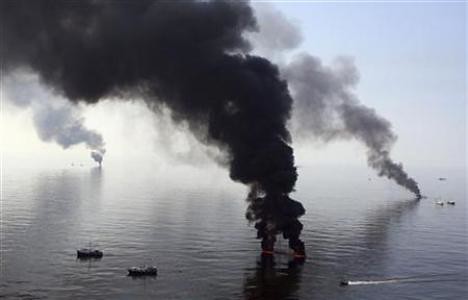
Oil explosion and leak in the Gulf. The environmental catastrophe is proving to be costly to the people of the region in regard to jobs, economic dislocation and political acrimony. The Obama administration is under pressure to resolve the crisis., a photo by Pan-African News Wire File Photos on Flickr.
November 12, 2012 7:34 pm
Risks cloud bright future for oil and gas
By Ed Crooks and Guy Chazan
Financial Times
When pundits bemoan the recent lack of any significant innovation to drive economic growth, they often forget the US oil and gas sector.
The industry’s resurrection, as described by the International Energy Agency, promises huge benefits for the US economy.
Yet there are still risks that could cloud that bright future.
The technologies that have unlocked previously inaccessible shale reserves are not new. Hydraulic fracturing – pumping water, sand and chemicals underground to release trapped hydrocarbons – goes back to the 1940s. Horizontal drilling was first commercially deployed in the 1980s. The combination of the two, used repeatedly in an industrial model that delivers ever-greater efficiency, has had dramatic effects.
Only five years ago it appeared that oil and gas production was on an inexorable downward trend in the US.
Now the IEA expects the country to be the world’s largest gas producer by 2015 and the largest oil producer (including other liquid hydrocarbons and biofuels as well as crude oil) by 2017.
The growth of US “tight oil” such as shale oil has been “nothing short of spectacular”, the IEA said. Production from the Bakken formation in North Dakota had grown to more than 600,000 b/d by mid-2012, while the Eagle Ford shale had gone from almost nothing three years ago to more than 300,000 b/d by mid-2012.
The effects of that revival are already being felt. In spite of the impression sometimes given by the industry’s cheerleaders, it cannot be a panacea for the problems of an economy that still has 4.2m fewer jobs than at the start of the recession in 2007, but it is making an important contribution nevertheless.
Direct employment in oil and gas production has risen 53 per cent over the past seven years to 195,100, while what the US Bureau of Labor Statistics calls “support activities for mining”, which includes many oil and gas services, is up 73 per cent at 365,000.
Beyond the direct employment, there are hundreds of thousands of jobs indirectly created. Companies have been increasing production to supply equipment and services the oil and gas industry needs. The Luxembourg-based steel tube manufacturer Tenaris, for example, is close to choosing a site for $1.5bn plant in Texas or Louisiana that will employ up to 4,000 people while under construction and up to 800 in operation.
Other companies are benefiting from the cheap oil and gas flowing on to the US markets. Refiners including Phillips 66 and ExxonMobil have recently reported bumper profits from their operations in the US.
Exports of petroleum products hit a record 2.5m b/d last year and have sustained that level in 2012.
The most profound impact has been in the chemicals industry, where there has been a flood of announcements from companies seeking to expand capacity in the US to take advantage of low energy costs and cheap natural gas liquids such as ethane and butane that are used as feedstocks.
Royal Dutch Shell, for example, is looking at building a multibillion-dollar ethane cracker in Pennsylvania.
In total, shale oil and gas companies will create about 600,000 new jobs directly and in their suppliers by 2020, according to IHS, the research company, and perhaps as many again in “induced” employment created as a result of the additional income generated.
Before those chickens are counted, however, the industry needs to prove it can increase production the way the IEA expects.
The American Petroleum Institute, the industry lobby group, talks about “an opportunity”, rather than a sure thing.
“The shale boom in America is just beginning,” it said on Monday.
Its concerns are focused on regulation. The Environmental Protection Agency and other government bodies are studying hydraulic fracturing and could come up with new rules next year that restrict the industry’s operations.
There are other reasons why the potential of shale might not be realised. New health risks might emerge. A shortage of water might constrain its use for fracking.
Above all, the newness of the industry means that there is still only limited evidence of long-term production performance.
Fatih Birol, the IEA’s chief economist, said the agency’s forecasts to 2017 were based on data about existing reserves and production, but warned that the geology and reservoir performance were “poorly known” and it was unclear whether new reserves would be found to sustain output into the future.
In the 2020s, he added, Saudi Arabia could be the world’s largest oil producer once again.
No comments:
Post a Comment